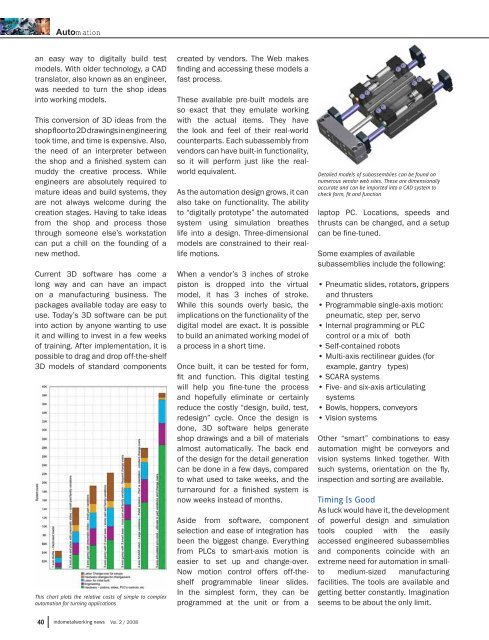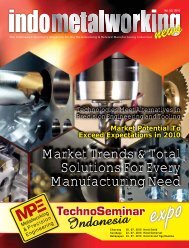High Speed Machining Precision Tooling - Indobiz.biz
High Speed Machining Precision Tooling - Indobiz.biz
High Speed Machining Precision Tooling - Indobiz.biz
You also want an ePaper? Increase the reach of your titles
YUMPU automatically turns print PDFs into web optimized ePapers that Google loves.
Automation<br />
an easy way to digitally build test<br />
models. With older technology, a CAD<br />
translator, also known as an engineer,<br />
was needed to turn the shop ideas<br />
into working models.<br />
This conversion of 3D ideas from the<br />
shop fl oor to 2D drawings in engineering<br />
took time, and time is expensive. Also,<br />
the need of an interpreter between<br />
the shop and a fi nished system can<br />
muddy the creative process. While<br />
engineers are absolutely required to<br />
mature ideas and build systems, they<br />
are not always welcome during the<br />
creation stages. Having to take ideas<br />
from the shop and process those<br />
through someone else’s workstation<br />
can put a chill on the founding of a<br />
new method.<br />
Current 3D software has come a<br />
long way and can have an impact<br />
on a manufacturing business. The<br />
packages available today are easy to<br />
use. Today’s 3D software can be put<br />
into action by anyone wanting to use<br />
it and willing to invest in a few weeks<br />
of training. After implementation, it is<br />
possible to drag and drop off-the-shelf<br />
3D models of standard components<br />
This chart plots the relative costs of simple to complex<br />
automation for turning applications<br />
created by vendors. The Web makes<br />
fi nding and accessing these models a<br />
fast process.<br />
These available pre-built models are<br />
so exact that they emulate working<br />
with the actual items. They have<br />
the look and feel of their real-world<br />
counterparts. Each subassembly from<br />
vendors can have built-in functionality,<br />
so it will perform just like the realworld<br />
equivalent.<br />
As the automation design grows, it can<br />
also take on functionality. The ability<br />
to “digitally prototype” the automated<br />
system using simulation breathes<br />
life into a design. Three-dimensional<br />
models are constrained to their reallife<br />
motions.<br />
When a vendor’s 3 inches of stroke<br />
piston is dropped into the virtual<br />
model, it has 3 inches of stroke.<br />
While this sounds overly basic, the<br />
implications on the functionality of the<br />
digital model are exact. It is possible<br />
to build an animated working model of<br />
a process in a short time.<br />
Once built, it can be tested for form,<br />
fi t and function. This digital testing<br />
will help you fi ne-tune the process<br />
and hopefully eliminate or certainly<br />
reduce the costly “design, build, test,<br />
redesign” cycle. Once the design is<br />
done, 3D software helps generate<br />
shop drawings and a bill of materials<br />
almost automatically. The back end<br />
of the design for the detail generation<br />
can be done in a few days, compared<br />
to what used to take weeks, and the<br />
turnaround for a fi nished system is<br />
now weeks instead of months.<br />
Aside from software, component<br />
selection and ease of integration has<br />
been the biggest change. Everything<br />
from PLCs to smart-axis motion is<br />
easier to set up and change-over.<br />
Now motion control offers off-theshelf<br />
programmable linear slides.<br />
In the simplest form, they can be<br />
programmed at the unit or from a<br />
Detailed models of subassemblies can be found on<br />
numerous vendor web sites. These are dimensionally<br />
accurate and can be imported into a CAD system to<br />
check form, fi t and function<br />
laptop PC. Locations, speeds and<br />
thrusts can be changed, and a setup<br />
can be fi ne-tuned.<br />
Some examples of available<br />
subassemblies include the following:<br />
• Pneumatic slides, rotators, grippers<br />
and thrusters<br />
• Programmable single-axis motion:<br />
pneumatic, step per, servo<br />
• Internal programming or PLC<br />
control or a mix of both<br />
• Self-contained robots<br />
• Multi-axis rectilinear guides (for<br />
example, gantry types)<br />
• SCARA systems<br />
• Five- and six-axis articulating<br />
systems<br />
• Bowls, hoppers, conveyors<br />
• Vision systems<br />
Other “smart” combinations to easy<br />
automation might be conveyors and<br />
vision systems linked together. With<br />
such systems, orientation on the fl y,<br />
inspection and sorting are available.<br />
Timing Is Good<br />
As luck would have it, the development<br />
of powerful design and simulation<br />
tools coupled with the easily<br />
accessed engineered subassemblies<br />
and components coincide with an<br />
extreme need for automation in smallto<br />
medium-sized manufacturing<br />
facilities. The tools are available and<br />
getting better constantly. Imagination<br />
seems to be about the only limit.<br />
40<br />
indometalworking news Vol. 2 / 2008




